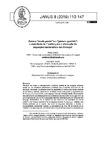Entre a muda poesia e a pintura que fala: o contributo de Camões para a afirmação da linguagem emblemática em Portugal

Use este enlace para citar
http://hdl.handle.net/2183/24389
A non ser que se indique outra cousa, a licenza do ítem descríbese como Atribución-NoComercial-SinDerivadas 4.0 España
Coleccións
Metadatos
Mostrar o rexistro completo do ítemTítulo
Entre a muda poesia e a pintura que fala: o contributo de Camões para a afirmação da linguagem emblemática em PortugalTítulo(s) alternativo(s)
Between “Mute Poetry” and “Speaking Painting”: Camões’ Contribution to the Flourishment of Emblematic Gender in PortugalAutor(es)
Data
2019Cita bibliográfica
Araújo, F. (2019) Entre a “muda poesia” e a “pintura que fala”: o contributo de Camões para a afirmação da linguagem emblemática em Portugal. Janus: estudios sobre el Siglo de Oro, 8, 113-147. http://www.janusdigial.es/articulo.htm?id=124
Resumo
[Resumen] Teniendo en cuenta la representación simbólica patente en las insignias militares
usadas por los caballeros medievales y sabiendo que la dinastía Avis hizo uso de
empresas personales, se pretende poner de manifiesto la continuidad de esa herencia
en las letras y cimeras utilizadas en las fiestas reales portuguesas y registradas por
el Cancioneiro Geral (1516) y por algunas crónicas contemporáneas. Relacionando
esta práctica con la sistematización de la heráldica llevada a cabo en el siglo XVI, se
procurará mostrar que la obra camoniana también presenta signos de recepción del
lenguaje emblemático, en la medida en que recurre a los conceptos de "muda
poesía" y de "pintura que habla "en la epopeya titulada Os Lusíadas. Además, este
estudio pretende dar a conocer una serie de empresas atribuidas a Camões y
supuestamente compuestas durante su permanencia en Goa. En el análisis de su
contenido, se tejen algunas consideraciones sobre el enfoque paródico propuesto por el poeta, comparándolo con otras adaptaciones posteriores. De acuerdo con esta
perspectiva, se intenta arrojar nueva luz sobre la contribución de Camões en la
consolidación de la emblemática en Portugal [Abstract] Taking the symbolic representation displayed on the medieval military insignias into
account and knowing that Portuguese dynasty of Avis made use of personal devices,
this study aims to show that the display of “letras” and “cimeiras” (verses and
images) in the royal festivities continued that historical legacy. The Cancioneiro
Geral (1516) and some contemporaneous chronicles provide evidence of that
practice, which can be related with the heraldic systematization led by Lusitanian
monarchs in the 16th century. Besides, it will be discussed whether or not Camões
was acquainted with the emblematic language, considering the way he deals with the
concepts of “mute poetry” and “speaking painting” in his epic poem entitled Os
Lusíadas. Additionally, this study seeks to divulge a set of devices attributed to
Camões, apparently composed during his stay in Goa. Through the analysis of this
material, some conclusions will be drawn on the parodic approach to emblematic
gender proposed by Luís Vaz, comparing it to posterior adaptations. According to
this perspective, new light will be shed on the importance of Camões’s contribution
to the flourishment of emblematic gender in Portugal
Palabras chave
Divisas
Empresas
Fiestas reales
Emblemática
Camões
Parodia
Devices
Badges
Royal festivities
Emblematics
Camões
Parody
Empresas
Fiestas reales
Emblemática
Camões
Parodia
Devices
Badges
Royal festivities
Emblematics
Camões
Parody
Versión do editor
Dereitos
Atribución-NoComercial-SinDerivadas 4.0 España
ISSN
2254-7290






